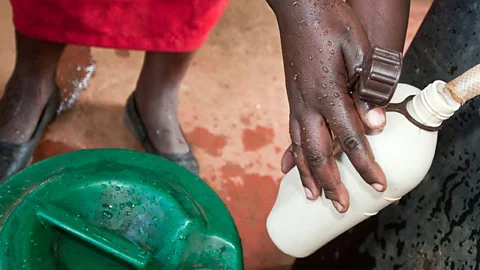Mobile phones call out for fresh water

 Jonathan Kalan
Jonathan KalanAn innovative system being tested across Kenya allows people to access drinking water at the touch of a button.
Spencer Ochieng is in the business of connecting remote villages in Kenya with water. But to do so he relies on an unusual tool. When most people dig down to check the water table below, Ochieng digs into his right pocket.
“The first thing we check for is availability of a strong mobile phone signal,” says Ochieng, general manager of Grundfos Lifelink, an organization that uses technology to provide safe drinking water to communities throughout the developing world.
Currently, there are nearly 1 billion people around the world with no access to clean water, and 13 million in Kenya alone with no access to a so-called “improved water system” – NGO-speak for anything that improves on collecting dirty water from rivers, lakes or ponds.
The Lifelink project was set up to tackle this problem using a solar-powered pump and a pay-per-use water tap, designed specifically for Kenya’s mobile-centered society.
The setup is relatively simple. Protected water is drawn from sources up to 250m underground by solar powered pumps. This is then held in an elevated storage tank, which is used to supply a tap in a secure, concrete kiosk. To access water, customers must first load money into their M-Pesa account — the ubiquitous mobile money payment and transfer service in Kenya used by more than 70% of the adult population. Then, through a simple text message, customers top-up the balance of their personal pre-paid Lifelink fob key. Once at the tap, customers simply wave their key at a sensor; money is debited from their account, and out flows 20 litres of pure drinking water.
“There’s a real need to provide drinking water to communities in a sustainable way,” Ochieng says. Every year thousands of deep wells, pumps, and boreholes are installed across the African continent by development organizations. Unfortunately, when funding dries up, so too does the water source. Studies have shown that as many as half of these projects are no longer working after two years. Pumps break. People stop paying. Wiring erodes. Parts vanish.
Seasonal flow
Ayaz Manji, head of water and sanitation at Kenya Red Cross, which helps Grundfos identify water-poor communities, says that the problem is all too common in Kenya. Although organisations typically form local ‘water committees’ to collect fees from users for repairs, Manji says that corruption and misappropriation is rampant.
“People use that money for other needs, or groups become politically inclined and that money disappears,” claims Manji.
The Lifelink system gets around this by collecting the fees people pay for water in a community M-Pesa account. It’s used to fund all repairs and maintenance and reduces the chance of corruption by keeping the money at arm’s length and all transactions virtual.
It’s a vital part of the system because maintenance is not cheap - Grundfos requires communities to save about 215,000 Kenyan Shillings (£1,500) a year for the service. This equates to customers paying roughly 3-4 Shillings (around two pence) per 20-litre jerry can of water, making it affordable to even the poorest. Any amount generated beyond the required savings amount is returned to the community.
To date, Grundfos has sold 38 Lifelink systems across Kenya, mostly purchased by development organisations, Kenya’s Water Board, or through Grundfos’ own corporate responsibility programs. Many serve hospitals, orphanages, and schools in remote areas.
According to the company, 75% of their systems are now self-sustaining. But the other quarter struggle to generate the necessary income for a mix of reasons. For example, the system has not worked in some northern regions of Kenya populated by nomadic herders. These herders tend to migrate with the seasons in search of fertile grazing pastures and water for their livestock, so there is not enough demand all year round. In other areas, people collect seasonal rainfall, meaning that the systems are underused and under-funded parts of the year.
Priced out
These kinds of temporal issues are not the only problem the project faces, however.
“In terms of tech solutions, it’s cutting edge,” Manji claims. But, in other ways “it’s not quite working”.
The biggest problem, he says, is that Grundfos is not collecting as much money as they expected to. “We’re in a social market. It’s a balancing act, so it’s not as easy as raising your tariffs. If you raise your tariffs, people go back to drinking from the river,” warns Manji.
Using mobile money to pay for and manage water resources may also limit how far outside of Kenya Grundfos hopes to expand. Though adoption is high in Kenya, mobile money has struggled to gain as impressive a foothold elsewhere in Africa.
The greatest barrier to adoption, however, is the price tag. Grundfos is a business, not a charity. Since they don’t profit from any of the fees, the up-front cost is steep - £30,000 per system. This makes it prohibitively expensive for individuals or even communities to purchase a system on their own - even if they can manage to sustain the upkeep.
Ochieng is working to address these problems and says the company is developing a new, more affordable version of the Lifelink system, which could be ready towards the end of 2013. Whether it will be enough top address the problems with the existing system remains to be seen.
Universal access to water may by a human right, says Ochieng, “but that right comes at a cost. And that cost needs to be shouldered by someone.”
If you would like to comment on this article or anything else you have seen on Future, head over to our Facebook page or message us on Twitter.
